About this Build
This years USACC build is a 1955 Ford Truck. We could use a pickup
or a panel van. I had a 55 Ford pickup in my stash; however, I
always wanted to do a panel van, or as they called them in that
era, a panel truck. I started my search for the 55 Panel Truck.
I really wanted the Moogram Kit #2772, the "Bootlegger"; however,
it is no longer available, but I found one on Ebay at a reasonable
price, so I grabbed it. The Scalemates information is in the
description of the box art image that is the first image of this
photo journal.
My 2nd Cousin, who we called Smokey, had just passed away at the
time of this build. He owned a plumbing business and in honor of
my cousin I decided to make this truck a plumbing service truck.
I always use the USACC build to try a lot of things that I never
tried before and I plan to make a lot of modifications to this
kit. Here are some of the modification and additions I'm planning on:
-
Putting a Chrysler 426 HEMI Engine under the hood.
-
Scratch building a roof rack.
-
Scratch building a working extension ladder.
-
I'm contemplating opening the back doors?
-
Using 3D printed wheels.
-
Making my own decals.
-
...and a surprise addition that you'll have to wait till the
build is finished to find out.
So...as the great one says, "And away we go!"
Photo/Video/Assembly Journal
93 Photos
Skip's Messy Workbench ⇔ All rights reserved ⇔ Copyright © 2023-2025
Skip's Messy Workbench
⇔ Last updated: August 08, 2025
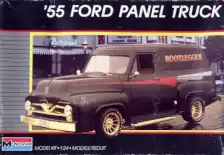 Box Art for the '55 Ford Panel Truck
Box Art for the '55 Ford Panel Truck
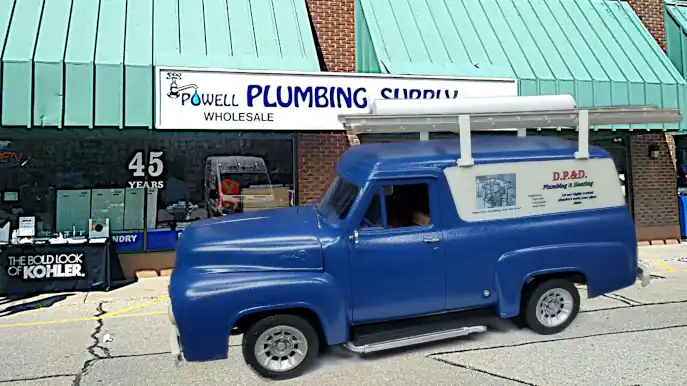

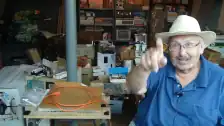 Created a ring to throw my hat in
Created a ring to throw my hat in
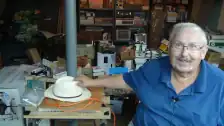 Threw my hat in the ring
Threw my hat in the ring
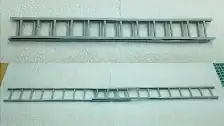 A scratch built 1:24 scale 24-foot extension ladder
A scratch built 1:24 scale 24-foot extension ladder
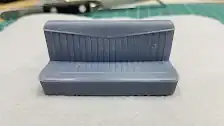 3D printed bench seat
3D printed bench seat
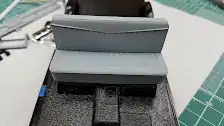 3D printed bench seat dry fitted to the interior tub
3D printed bench seat dry fitted to the interior tub
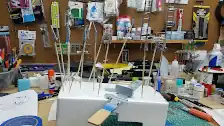 Some small parts have been primed and waiting to dry
Some small parts have been primed and waiting to dry
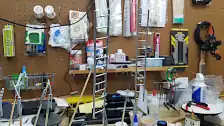 Scratch built ladder painted with Vallejo 77.701 aluminum drying
Scratch built ladder painted with Vallejo 77.701 aluminum drying
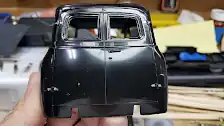 Back door hinge locations are marked
Back door hinge locations are marked
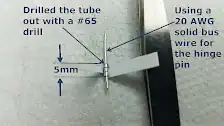 Rear door hinge concep
Rear door hinge concep
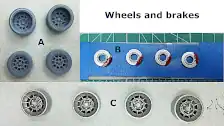 Wheels, brake rotors and calipers
Wheels, brake rotors and calipers
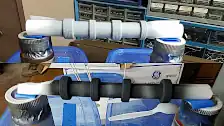 Tires primed and painted Tamiya Rubber Black
Tires primed and painted Tamiya Rubber Black
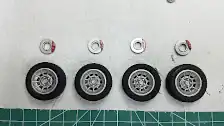 ires and wheels assembled
ires and wheels assembled
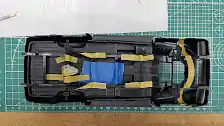 Frame, interior tub, rear differential and front suspension dry fitted
Frame, interior tub, rear differential and front suspension dry fitted
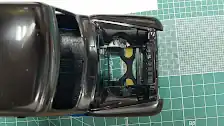 Checking engine compartment clearance with radiator installed
Checking engine compartment clearance with radiator installed
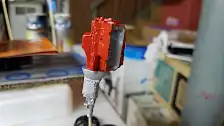 How did the 426 Hemi get it's name
How did the 426 Hemi get it's name
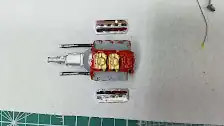 Hemi engine dual carburetors and exhaust manifolds installed
Hemi engine dual carburetors and exhaust manifolds installed
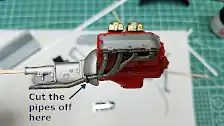 Exhaust manifold pipe had to be cut
Exhaust manifold pipe had to be cut
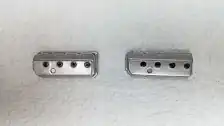 Valve covers painted with Vallejo 77.716 Semi Matt Aluminum
Valve covers painted with Vallejo 77.716 Semi Matt Aluminum
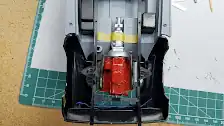 Hemi engine being dry fitted into the frame
Hemi engine being dry fitted into the frame
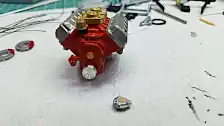 Valve covers, distributor cap and crank pulley installed
Valve covers, distributor cap and crank pulley installed
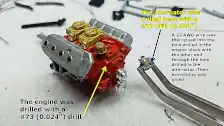 Water pump and alternator pulley mounted and engine drilled to mount alternator
Water pump and alternator pulley mounted and engine drilled to mount alternator
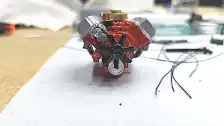 Font of completed engine with fan and belt installed
Font of completed engine with fan and belt installed
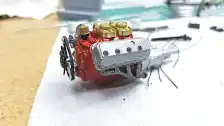 Photo of engine from the right front corner
Photo of engine from the right front corner
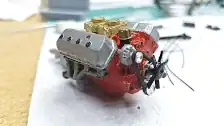 Photo of engine from the right front corner
Photo of engine from the right front corner
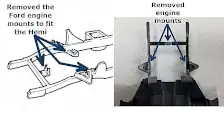 Ford engine motor mounts had to be removed from the frame
Ford engine motor mounts had to be removed from the frame
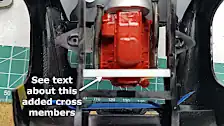 First attempt at a hemi motor mount
First attempt at a hemi motor mount
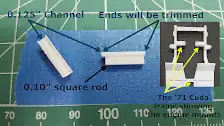 New scratch built motor mounts using channel and square stock
New scratch built motor mounts using channel and square stock
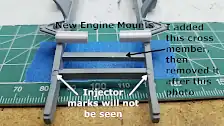 New scratch built motor mounts installed on the frame
New scratch built motor mounts installed on the frame
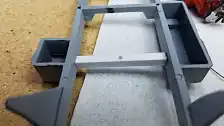 New cross member with a hole in the center for mounting the transmission to the frame
New cross member with a hole in the center for mounting the transmission to the frame
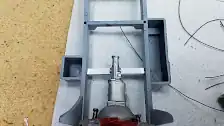 Transmission positioned on the new cross member
Transmission positioned on the new cross member
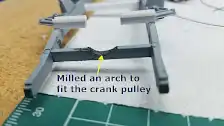 Front frame cross member cut out to allow the crank pulley to clear the frame
Front frame cross member cut out to allow the crank pulley to clear the frame
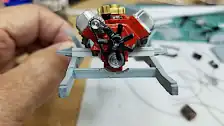 Hemi dry fitted on new mounts
Hemi dry fitted on new mounts
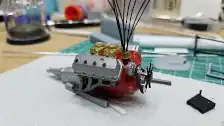 Spark plug and coil wire installed in the distributor cap
Spark plug and coil wire installed in the distributor cap
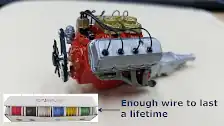 Wired engine left side
Wired engine left side
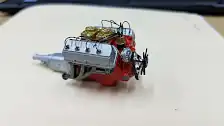 Wired engine right side
Wired engine right side
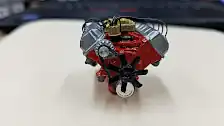 Wired engine front view
Wired engine front view
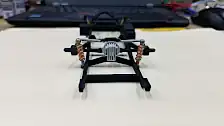 Rear axle, differential and coil over shocks installed
Rear axle, differential and coil over shocks installed
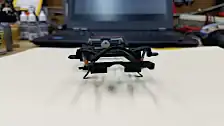 Front shocks are installed
Front shocks are installed
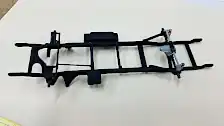 Bottom view of the frame
Bottom view of the frame
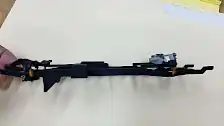 Side view of the frame
Side view of the frame
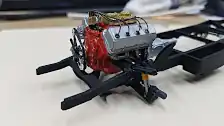 Engine mounted on the frame
Engine mounted on the frame
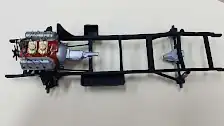 Top view of the frame with the engine mounted
Top view of the frame with the engine mounted
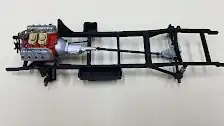 The drive shaft has been installed
The drive shaft has been installed
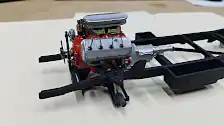 The air cleaner is installed on the engine
The air cleaner is installed on the engine
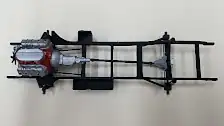 Top view of the frame
Top view of the frame
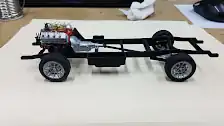 Side view of the wheels and tires are installed on the frame
Side view of the wheels and tires are installed on the frame
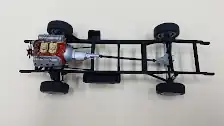 Top view of the chassis with the wheels and tires installed
Top view of the chassis with the wheels and tires installed
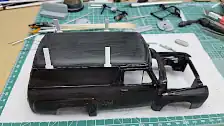 Body sanded and roof rack uprights are installed
Body sanded and roof rack uprights are installed
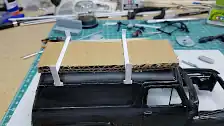 Card board used as a spacer to mount the roof rack cross members.
Card board used as a spacer to mount the roof rack cross members.
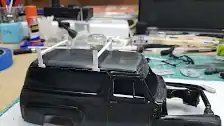 The Roof racks are installed
The Roof racks are installed
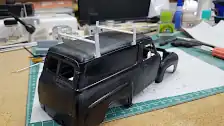 Back view of the installed roof racks.
Back view of the installed roof racks.
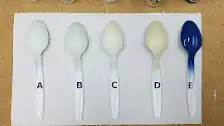 Test spoons for body colors
Test spoons for body colors
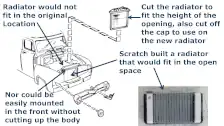 Scratch built a cross-flow radiator
Scratch built a cross-flow radiator
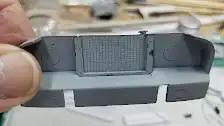 Scratch built radiator fits perfectly in the opening, front view
Scratch built radiator fits perfectly in the opening, front view
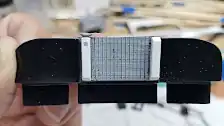 This is the radiator from the back side, the engine bay side
This is the radiator from the back side, the engine bay side
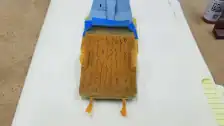 Attempting to paint wood grain
Attempting to paint wood grain
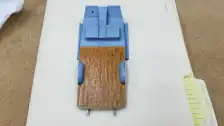 Truck bed with the masking tape removed
Truck bed with the masking tape removed
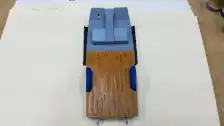 Interior tub and running boards painted
Interior tub and running boards painted
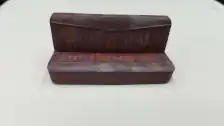 Leather seat painted
Leather seat painted
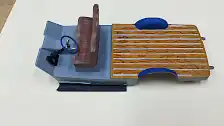 Interior tub is finished
Interior tub is finished
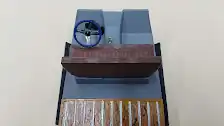 The interior tub looking from the back of the van
The interior tub looking from the back of the van
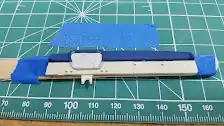 Dash board is painted
Dash board is painted
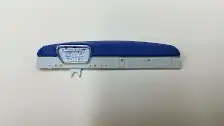 Detailed dash board
Detailed dash board
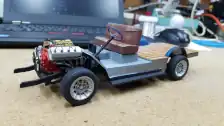 Interior tub setting on the frame, left side
Interior tub setting on the frame, left side
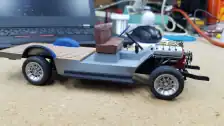 Interior tub setting on the frame, right side
Interior tub setting on the frame, right side
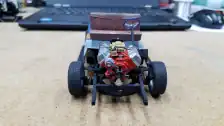 Interior tub setting on the frame, from the front
Interior tub setting on the frame, from the front
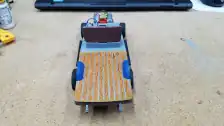 Interior tub setting on the frame, from the back
Interior tub setting on the frame, from the back
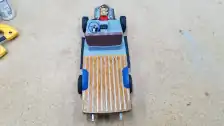 Interior tub from back showing small instrument cluster
Interior tub from back showing small instrument cluster
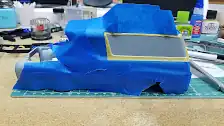 Body is masked for painting the side panels
Body is masked for painting the side panels
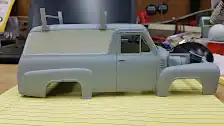 Mask removed showing the side panels
Mask removed showing the side panels
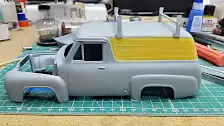 Side panels masked so that body can be painted
Side panels masked so that body can be painted
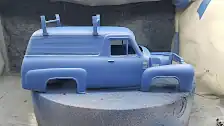 First coat of body color applied to body
First coat of body color applied to body
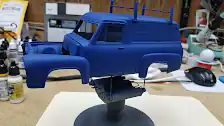 Second and third coat on the body
Second and third coat on the body
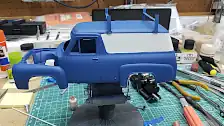 Side panel masking removed
Side panel masking removed
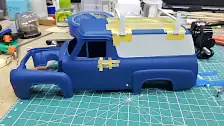 Roof racks and chrome parts were painted
Roof racks and chrome parts were painted
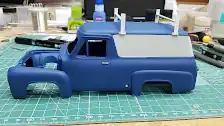 All the masking tape was removed
All the masking tape was removed
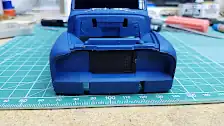 The front of the body with the radiator were installed
The front of the body with the radiator were installed
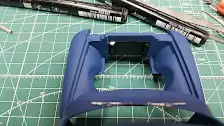 Engine compartment view from the roof
Engine compartment view from the roof
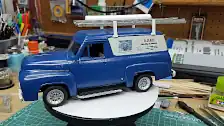 Completed Build
Completed Build
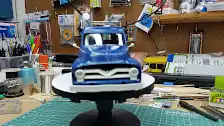 Completed Build
Completed Build
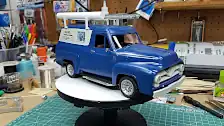 Completed Build
Completed Build
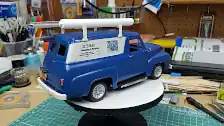 Completed Build
Completed Build
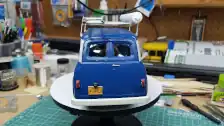 Completed Build
Completed Build
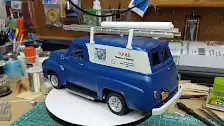 Completed Build
Completed Build
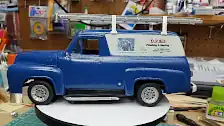 Completed Build
Completed Build
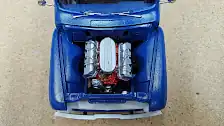 Hood open looking at the engine
Hood open looking at the engine
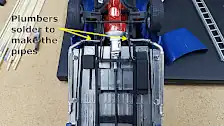 Exhaust pipes made from solder to join with the side pipes
Exhaust pipes made from solder to join with the side pipes
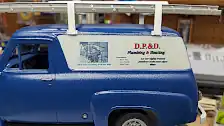 My custom decal
My custom decal
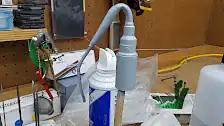 A moonshine still
A moonshine still
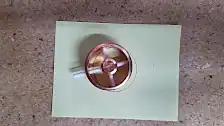 Burner to heat the still
Burner to heat the still
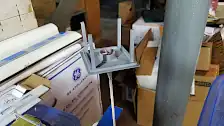 Scratch built table with burner mounted on the bottom
Scratch built table with burner mounted on the bottom
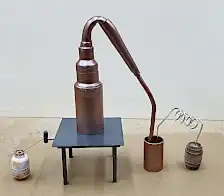 The completed still
The completed still



